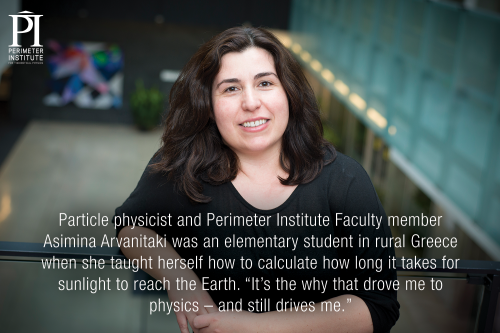Tag archives: telescope
Chinese astronomers pin their hopes on LOT

Lei Hao from the Shanghai Astonomical Observatory.
By Michael Banks in Shanghai, China
It was a cold, rainy day here in Shanghai, so coming from the UK, I felt right at home.
Jumping into a Shanghai taxi to avoid the downpour, I headed to the Shanghai Astronomical Observatory, belonging to the Chinese Academy of Sciences, to meet astronomer Lei Hao.
View all posts by this author | View this author's profile
Inspiring young physicists, telescope buyer’s guide, time-travelling pyramid builders

Sunlight calculator: Asimina Arvanitaki. (Courtesy: PI)
By Hamish Johnston
Have you ever wondered what inspires talented physicists to pursue careers in physics? To try to answer that question, the Perimeter Institute for Theoretical Physics (PI) in Canada has produced a set of tiles that explain how some famous physicists – and some up-and-coming stars – became hooked on physics at a young age. An early love of back-of-the-envelope calculations seems to have set the stage for the PI’s Asimina Arvanitaki as she explains in the above tile. Can you guess which Nobel laureate used to stare at a clock pendulum for hours to try to figure out how it worked? The answer to that teaser and much more can be found in “How great scientists get hooked on science”.
View all posts by this author | View this author's profile
Starry Starry Night
By Tushna Commissariat
It is commonly thought that astronomy and astrophotography are rather exclusive hobbies and that you require a lot of specialist equipment and training to pursue them. But an amateur astrophotographer, using only his ordinary digital SLR camera, a tripod and his love for the skies, has won the major astrophotography prize at the inaugural STARMUS festival.
Not only did Alex Cherney win the opportunity to attend and mingle with the who’s who of astronomy at the STARMUS festival – an astronomy and space-science festival held in the Canary Islands this June – but the Australian amateur astronomer also won an hour using one of the largest optical telescope on the planet – the 10.4 m Gran Telescopio Canarias (GranTeCan), in the Canary Islands in Spain.
Cherney’s prize-winning collection of time-lapse sequences of the Milky Way, seen over the Southern Ocean, beat a bevy of global participants for the best entry as judges felt his scenes were “chosen with the eye of an artist” and that his “subtle panning and excellent control of colour and contrast revealed technical skills of the highest order”. Cherney uses only his Nikon D700 DSLR camera and produced a compilation of images taken over 31 hours of exposure time.
This is notably the first time an amateur astronomer has been allowed access to the GranTeCan and Cherney was keen to make the most of the opportunity. After much deliberation, he decided to use his hour to observe and photograph Arp84, a pair of interacting galaxies – NGC5394 and NGC5395. (Image above courtesy: Alex Cherney)
“I wanted an object that would look nice given the parameters of the telescope and has not been photographed in colour and great detail by a professional telescope,” he said. Noel Carboni, an astro-image-processing expert, met Cherney at the festival and helped to produce a colour image. Carboni feels this is the clearest image of Arp84 ever made. Cherney felt the experience of using the telescope was “incredible”, akin to taking a space flight. “It is very hard to describe what it is like to observe space with an instrument that is helping scientists seek answers to the origin of the universe.”
Cherney put his opportunity of being at the La Palma observatory to good use, producing another time-lapse video featuring GranTeCan and MAGIC (Major Atmospheric Gamma-ray Imaging Cherenkov Telescopes) as the backdrop for the night skies. Take a look at the stunning video below.
Outer Space from Alex Cherney on Vimeo.
View all posts by this author | View this author's profile
Mysterious ‘superflares’ confound astronomers
By Tushna Commissariat
Most of us with an interest in astronomy would recognize the Crab Nebula in images and videos quite readily. The supernova remnant, first seen on Earth in the year 1054, consists of a super-dense neutron start that spins about 30 times an second, making it a pulsar that swings a beam of radiation towards Earth, like a lighthouse.
NASA’s Fermi Gamma-ray Space Telescope is one of many that look for high-energy radiation sources, and recently the Crab Nebula has caught its eye. The past seven months have seen some rather dramatic variations within the nebula, with Fermi and other telescopes noticing X-ray flares a hundred times brighter than seen ever before.
Since 2009 Fermi has detected several short-lived gamma-ray flares at energies greater than 100 million electron volts (eV), which is much higher than the flares seen before. On 12 April Fermi detected a flare that grew about 30 times more energetic than the nebula’s normal gamma-ray output and about five times more powerful than previous outbursts. On 16 April an even brighter flare erupted, which lasted for a few days before the activity died out.
“These superflares are the most intense outbursts we’ve seen to date and they are all extremely puzzling events,” says Alice Harding of NASA’s Goddard Space Flight Center. “We think they are caused by sudden rearrangements of the magnetic field not far from the neutron star, but exactly where that’s happening remains a mystery.”
When Fermi noted the variances in 2010 it alerted NASA’s Chandra X-ray Observatory, which began routinely monitoring the nebula to identify X-ray emissions associated with the outbursts. When Fermi scientists alerted the astronomers at Chandra about the spike in April, a pre-planned set of observations using the observatory was initiated.
Unfortunately, no clear evidence was seen for correlated flares in the Chandra images, so the reason for the sudden extreme variations is still a mystery. Theorists have deduced that the flares must arise within about one-third of a light-year from the neutron star, but efforts to locate them more precisely have been unsuccessful.
Scientists believe the flares occur as the intense magnetic field near the pulsar undergoes sudden structural changes. Such changes can accelerate electrons to velocities near the speed of light. As these relativistic electrons interact with the magnetic field, they emit gamma rays. To account for the observed emission, scientists say the electrons must have energies 100 times greater than can be achieved in any particle accelerator on Earth. This makes them the highest energy electrons associated with any source within our galaxy.
Take a look at the wonderful video by NASA that shows the changes as seen by Chandra, as well as some spectacular shots of the nebula.
View all posts by this author | View this author's profile
